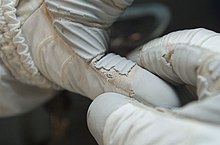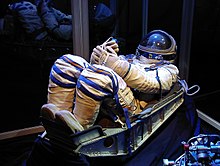Spacesuit
The space suit is a gas-tight protective suit for space travelers , which in the vacuum of space secures the vital functions (especially breathing ) of the wearer by putting himself under positive pressure . An oxygen device attached to or built into the suit removes the carbon dioxide exhaled by the wearer and replaces it with oxygen .
Areas of application
The following areas of application can be distinguished for spacesuits:
- Rescue suits: They are only worn by the crew inside the spacecraft during dangerous maneuvers such as during launch, docking and landing of the spacecraft in order to ensure the oxygen supply in the event of a failure of the pressurized cabin of the vehicle. So you only protect the crew for a short time. From a height of 12,000 m breathing pure oxygen is sufficient not to the for oxygen saturation to achieve required blood oxygen partial pressure. This is remedied by suits with overpressure inside. This overpressure enables the wearer to breathe sufficient amounts of oxygen. Pilots of very high-flying (military) aircraft (for example the Lockheed U-2 or Lockheed SR-71 ) and stratospheric jumpers also wear such pressure suits. Examples of rescue suits are the Russian Sokol suit for occupants of Soyuz spacecraft and the orange ACES space suit for space shuttle crews.
- Spacesuits for Except board activities ( English Extra-vehicular activity , EVAs ). When working in space outside of the spacecraft or the space station , spacesuits with a mobile oxygen supply are usually worn on the wearer's back. They must have special insulating functions, protective layers against micrometeorites and a climate system to support the body temperature. Such suits are called Extravehicular Mobility Units (EMUs) at NASA . In addition to the US EMU (which can be used from the ISS ), the Russian suits of the Orlan family belong to this group. A common Russian name for a space suit is scaphander .
Flight suit
The space suit is not to be confused with the flight suit , a hard-wearing overall made of fire-resistant fabric. This is worn by astronauts during training, on official occasions and often when working on board the spacecraft, but also by aerobatics , the crews of military aircraft or during test flights ( e.g. parabolic flights ).
Structure of a spacesuit
Every space suit consists of numerous layers of different textiles, plastics and often metals. In the innermost layer, hoses are inserted through which cold water is pumped so that the spaceman in his suit does not overheat. Above that there is a layer of neoprene , which is gas-tight but flexible and can therefore hold the overpressure. In addition, the neoprene layer is surrounded by another strong textile layer. The outer suit layers are made of robust, fire-retardant aramid fibers . Space suits for outboard work are also coated on the outside with aluminum or other fabrics to reflect solar radiation. These two outer layers also protect the wearer from micrometeorites and radiation.
So that the suit does not inflate excessively in the vacuum and make the space traveler immobile, the pressure in the suit is reduced as much as physiologically possible compared to the earth's atmosphere. Depending on the atmosphere in which the astronaut was before the exit, an adjustment to the reduced pressure is therefore necessary in order to prevent decompression sickness. For example, on the ISS, an external space suit must be prepared by breathing pure oxygen for several hours, as the gas atmosphere in the residential modules largely corresponds to the earth's atmosphere (21 percent oxygen, 78 percent nitrogen, 1014 hectopascals pressure). A pure oxygen atmosphere was created in the spaceships of the Apollo program after the start. An exit in a spacesuit was therefore possible without such a 'camp out'.
A nearly spherical helmet is placed on the head of the space traveler, connected to the space suit in a gas-tight manner and provided with a folding visor against the aggressive UV radiation of the sun (the space traveler is beyond the ozone layer ). The connections for oxygen, exhaust air, cooling water and communication systems are usually located in the fuselage area.
history
1930s
The modern spacesuits have their origin in the pressure suits developed in the 1930s for deep-sea divers ( diving suits ) and test pilots of very high-flying military aircraft. However, these original suits had one major disadvantage: You could hardly move in them - either they were too stiff or bulky from the start, or they became so at the latest when the pressure was built up from the inside. Two basic forms quickly established themselves: One was "soft" suits that offered a certain degree of mobility, but did not provide complete protection. The "hard" suits (as suggested by Herman Potočnik in 1928 ), on the other hand, were safer, but extremely bulky. Most test pilots who went to great heights used soft suits. A more balanced solution was sought for the future space travelers. Today they use tough suits with greater flexibility. The evolution of the space suit can be traced in the following steps: In 1931 the Russian Yevgeny Tschertowski developed an impractical pressure suit in Saint Petersburg. In 1933, the American Mark Ridge survived an atmospheric pressure of 27,500 meters in a simulation chamber in a suit developed by British engineers John Scott Haldane and Sir Robert H. Davis (from Siebe Gorman & Co. Ltd in London). In 1934, American pilot Wiley Post and designer Russell Colley of the Goodrich Company developed a suit that resembled that of a deep-sea diver. However, one of these early models broke; another had to be cut open to free the porter. In 1935, Post reached a height of 15 kilometers for the first time with an improved model. In the same year, the German company Dräger , which specializes in diving suits, produced a suit made of silk and rubber covered with silk cord. When pressurized, however, the suit inflated to such an extent that the eye window was pushed onto the pilot's forehead. A French development from the same year consisted of linen, silk and rubber and featured gloves with spring tension so that the pilot could flip a chest lever that controlled the internal pressure of the suit. The first tough suit appeared in the late 1930s. However, this Italian make turned out to be too bulky and heavy, so that the pilots had to be carried to the aircraft after squeezing themselves into the suit from behind.
1940s
In 1940, a rubberized British suit with an oxygen bottle mounted on the thigh and adjustable leg lacing up to a height of about 10,000 meters proved its worth. In the same year, the first US space suit was commissioned by Army aviators. It weighed about 35 kilograms and became completely rigid at 200 hPa; this was 35 hPa less than the pressure required to sustain life in space. In 1942, the Army aviators tested, among other things, a suit model with the designation XH-1. However, it had a number of disadvantages, such as poor ventilation properties and unwieldiness once it was under pressure. A hard suit that was further developed by Dräger at the same time, reminiscent of medieval knight armor, was more flexible than most others and could withstand high internal pressure, but like many other hard suits it was too heavy. In 1943, a caterpillar inspired inventor Russel Colley to create a construction with segment-like ribbed arm and leg parts that allowed the wearer to lift and move his limbs. Together with its cheese-bell-shaped plastic helmet, it became the model for numerous spacesuits in science fiction literature and SF films of the 1950s and early 1960s.
1950s and 1960s
In the early 1950s, the David Clark Company - a manufacturer of pressure suits since 1939, but also a manufacturer of bras - developed a suit made of nylon fabric with a waffle structure. In 1960 a pressure suit was presented to the world public in the Soviet Union, which was astonishingly similar to that of the U-2 pilot Gary Powers , who was shot down over the Urals and then captured . In 1962, the British presented a very light suit, which, however, obstructed the view and became quite rigid. It had a rear zip entry, like the later Apollo program space suits.
The crews of the first spacecraft Vostok and Mercury wore space suits in case the air escapes from the spacecraft . The Mercury spacesuits had a vapor-deposited outer layer made of aluminum to reflect solar heat radiation, were made of nylon and rubber, weighed only nine kilograms and also had the best ventilation properties. They had previously been tested on the flights of the X-15 rocket plane .
These suits were further developed for the first space exits in the mid-1960s. So-called experimental suits were used for this. In 1964, Litton Industries manufactured the prototype of a tough suit with knee-tube joints, twist locks and no zipper for NASA . For the missions of the Apollo program , however, soft suits were used, which offered more mobility. In 1965 the David Clark Company manufactured a special space suit for the Gemini program with its planned space exits, which had a gold-coated, glare-free helmet visor and also kept the exhaled air away from the nose and mouth. The spacesuits for the Apollo program, in which space travelers were supposed to move on the lunar surface, had to be completely redesigned. ILC Dover was awarded the contract for the development and production of the A7L spacesuit by NASA.
1970s until today
The Soviet cosmonauts on the missions to the Salyut space station in the 1970s and 1980s wore soft spacesuits during take-off, landing and relocations, while the suits used for space exits were hard suits with rear entry. The US astronauts of the Space Shuttle , which was used from the 1980s onwards, wore hybrid models in which hard and soft materials were combined. This type of suit offers security and mobility. Today's US American EMUs are, in principle, further developments of the Apollo spacesuits, but with stiffening made of fiberglass- reinforced plastic in the torso area.
In the 1970s, a small rescue capsule, the Personal Rescue Enclosure, was developed for use in the space shuttle . It was spherical and flexible like a spacesuit and offered space for an astronaut.
For the summer and autumn 2012 jumps performed by Felix Baumgartner from a height of 39 km as part of the Red Bull Stratos project , a short-term suit for 0.24 bar internal pressure was developed for falling at more than the speed of sound - in a thin atmosphere at −68 ° C.
Accidents

Because of the task and use of a space suit - especially with regard to the external activities of the wearer - a space suit is comparable to a portable spaceship. In contrast to the spacecraft, such as the space capsules used in the Apollo program , working with the space suit has so far not resulted in a disaster. However, there was almost a catastrophe during the flight from Vozhod 2 in 1965. At that time, the Soviet cosmonaut Alexei Leonov had undertaken the first space exit for a few minutes. When he wanted to return to the spaceship through the exit lock, his protective suit had stiffened so much from the internal pressure that he no longer had enough freedom of movement to get into the narrow lock. The pressure in the suit filled with pure oxygen could be reduced from 0.40 bar to 0.23 bar. With this mode, which was prepared in advance for emergencies, Leonow was able to make the suit more flexible and return to the airlock.
On August 15, 2007, the eighth day of flight of the STS-118 mission to the International Space Station , an spacecraft mission to expand the ISS was prematurely canceled. Mission specialist Mastracchio had to return to the airlock because of a tear in the top layer of his glove.
Water leakage
On July 16, 2013, a serious incident involving a US spacesuit ( EMU ) occurred as part of the ISS Expedition 36 during the EVA-23 spacecraft mission . 44 minutes after he got out, ESA spaceman Luca Parmitano reported that water had penetrated his helmet. Initially, a leak was suspected in his drinking water bag. When Parmitano had emptied it and the amount of water in the helmet continued to increase, the mission was immediately canceled. On returning to the airlock, large amounts of water got into the helmet and impaired Parmitano's vision, breathing and speech. In the end, there was an estimated 1.5 liters of water in the suit, which posed a risk of drowning for the astronaut. The cause of the leak turned out to be a clogged pump in the system for regulating the temperature of the spacesuit, whereby water from the cooling circuit got into the breathing air. A NASA investigation report published on February 27, 2014 acknowledged that the water problem, while known, was underestimated.
On February 25, 2015, during the second spacecraft mission of ISS Expedition 42 , water also penetrated the EMU helmet of Terry Virts , but in a much smaller amount than before at Parmitano.
future
The spacesuits used today are hardly suitable for later missions to the moon or Mars because of their high mass and poor mobility when inflated. Originally (for example by experts at NASA), suits were proposed here that are similar to armor and armored diving suits made of stiff, break-proof plastic parts with joints in between. For reasons of weight and mobility, however, this solution is not optimal.
An alternative construction called Bio Suit is or was being developed at the Massachusetts Institute of Technology : a skin-tight elastic full-body suit made of latex with embedded nanoplastic plates to protect against micrometeorites and solar radiation, which prevents the wearer's body from expanding. Only the helmet is put under pressure as usual.
NASA is developing a new space suit for the Artemis moon landing program.
Smell of spacecraft
According to several astronauts, the space suits smell discreetly of burnt meat, charcoal , gunpowder , welding smoke , metal , sparkler , brake lining , walnut or wet laundry after spacecraft missions at the International Space Station .
See also
- Hard upper torso , part of many spacesuits
- Life support system , part of all spacesuits
literature
- Nicholas de Monchaux: Spacesuit. Fashioning Apollo. The MIT Press. Cambridge, Massachusetts 2011
- Eugen Reichl: Correctly dressed in everyday life. In: Star Observer Nov./Dec. 2003, pp. 48-54.
Web links
- How Spacesuits Work
- EVA Support Information - Brochure from ESA on the use of spacecraft and space suits when installing the Columbus ISS module (PDF; 1 MB)
- Suited for Spacewalking (PDF; 4.6 MB)
- Video: how does a spacesuit work? . German Aerospace Center 2014, made available by the Technical Information Library (TIB), doi : 10.5446 / 15410 .
Individual evidence
- ↑ Rescue Ball in the Encyclopedia Astronautica , accessed on October 18, 2017 (English).
- ↑ Medical aspects of the Stratos mission , sport.ORF.at of October 7, 2012
- ↑ Luca Parmitano: EVA-23 - Ausloten Ausloten ausloten , ESA-Deutschland, accessed February 27, 2014
- ↑ Defective equipment: NASA knew about water hazards in spacesuits , Spiegel Online, February 27, 2014
- ↑ After 2nd spacewalk, astronaut reports water in helmet. Washington Post , February 25, 2015, accessed February 25, 2015 .
- ^ A Next Generation Spacesuit for the Artemis Generation of Astronauts . NASA, October 8, 2019.
- ^ William Harwood: NASA unveils high-tech spacesuits for upcoming Artemis moon program . CBS News, October 15, 2019.
- ↑ Megan Garber: What Space Smells Like. July 19, 2012, accessed July 13, 2020 (American English).
- ↑ WORLD: "The universe smells of brake pads" . In: THE WORLD . August 20, 2014 ( welt.de [accessed July 13, 2020]).
- ↑ What does space smell like? Retrieved July 13, 2020 .
- ↑ Boris Pofalla: Astronaut Scott Kelly's biography: How does space actually smell? In: THE WORLD . November 10, 2017 ( welt.de [accessed July 13, 2020]).




